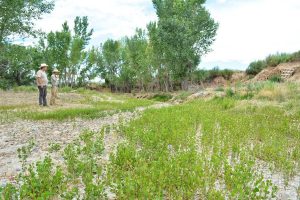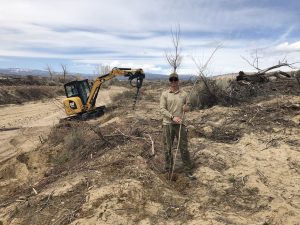Riparian Restoration
The Riparian Restoration committee was formed to improve riparian habitats through site assessments, data gathering, restoration, and monitoring and maintenance. Active partners of this committee include Grand Staircase Escalante Partners (GSEP), Southwest Conservation Corps, Utah Conservation Corps, Arizona Conservation Corps, Ancestral Lands Conservation Corps, US Forest Service – Dixie National Forest, U.S. Fish and Wildlife – Partners for Fish and Wildlife program, National Resource Conservation Service, and UT Forestry, Fire, and State Lands. See below to read more about some of this committee’s work! If you have questions or would like to get involved, please contact the coordinator:
Kevin Berend, Conservation Programs Manager, 435-826-4737; kevin@gsenm.org
Woody Invasive Removal

Russian olive trees along the Escalante River threaten populations of numerous native animal and plant species. These non-native trees constrain the river channel, change flooding dynamics, and alter water temperature and chemistry while also restricting access for visitors. Since becoming established on the river as a dominant tree in the mid-1980s, Russian olive has been channelizing the river, trapping sediment, and shading the river. Russian olive also directly impacts fish habitat by reducing riffles, deepening channels, and burying rocky stretches. Russian olive provides poor quality habitat for most Neotropical birds, and will degrade and even eliminate native vegetation as it invades riparian zones. Several candidate and Utah Wildlife Action Plan (WAP) species occur in these riparian communities and the river itself, including Flannelmouth sucker, Bluehead sucker, Roundtail chub, speckled dace, Bell’s vireo, Lucy’s warbler, Virginia’s warbler, and northern leopard frog. Neotropical migrants, such as Lucy’s warbler, Yellow-breasted Chat, Bell’s vireo, and Bullock’s oriole will benefit directly from this project as native riparian vegetation is restored through removal of Russian olive. Virginia’s warbler and several hummingbird species use the Escalante River corridor for foraging and migration and benefit from this ongoing work.
Riparian ecosystems comprise a very small portion of the landscape of the Escalante, yet they are disproportionately important to wildlife and plants, typically supporting far greater species diversity than the surrounding upland ecosystems. This work preserves and protects the diversity of a naturally functioning watershed for future generations. Removing the impenetrable thickets of Russian olive allows for visitors and wildlife to move through the frontier landscape, enjoying the wilderness as it was historically, before the invasion of exotic species. Without this work, the quality of the Escalante Watershed and its associated ecological values, wildlife and access, would continue to degrade, rendering many canyons virtually inaccessible and the quality of habitat unfit to support diverse wildlife.
ERWP has developed a science-based Ten Year Action Plan and a Woody Invasive Control Plan, which guides efforts to restore the ecological functions and processes of a healthy watershed. These plans identify the vision for woody invasive species treatment in the watershed:
Reduce through various control methods Russian olive and other woody invasive species in the watershed to minimal levels, thereby allowing native plants and animals to thrive and natural (historical) riparian process to function, such that riparian areas become more naturally functioning, sustainable and resilient to change.
In 2019, ERWP reached an important milestone: the completion of initial treatments on public land for the entire watershed! Following this hard-won goal, the Russian olive project entered the “maintenance” phase. This phase is critical to protecting the 10 years and millions of dollars devoted to the project. We continue to retreat and monitor the riparian areas of the watershed as we move forward with restoration and conservation of the watershed.
Monitoring
The central objective of Escalante’s rapid vegetation monitoring program is to quantify the effectiveness of our restoration efforts and, more generally, our progress toward realizing our riparian restoration objectives. Most importantly, this monitoring aims to quantitatively measure the change in woody invasive presence and use these data to extrapolate to the entire riparian area of the watershed. Our goal is to monitor one-third of the watershed each year. Therefore, every three years, we complete a full assessment of the watershed. Metrics that measure progress toward goals include: 1) Reducing Russian olive relative cover to <5%, 2) >90% relative cover of native woody species, 3) evidence of natural recruitment of native species 4) >50% relative cover of herbaceous native species, and 5) <10% relative cover by secondary weed species of concern.
To build on the rapid monitoring data, a long-term goal is to implement hypothesis-driven monitoring of river geomorphology and riparian vegetation following Russian olive removal. Anecdotal evidence indicates that the invasion of Russian olive created levees, narrowed the existing channel, which in turn reduced in-channel aquatic habitat and limited reproduction of native species by reducing channel movement. Such information can be used to develop hypothesis-driven monitoring. If the invasion of Russian olive along the Escalante River did indeed alter fundamental geomorphic patterns and processes, the large-scale removal of Russian olive should produce predictable outcomes. For example, from a geomorphic perspective, we would hypothesize that Russian olive removal would result in: 1) widening of the Escalante River channel; 2) more active channel movement, such as meander bend migration or channel realignment. Such hypotheses could be directly evaluated and quantified over large spatial and temporal scales by examining high resolution imagery on annual, or longer, time steps to monitor channel width and alignment following Russian olive removal. Validation of these hypotheses would provide direct evidence of the effectiveness of removal efforts, which would in turn benefit and inform future removal efforts elsewhere.
Legacy Cottonwood Study
Prior to European settlement, gallery forests of large cottonwood trees with under-stories of willow and other water dependent vegetation occupied significant stretches of the Escalante River. Habitats such as these are among the most biologically important within the watershed, especially for neotropical birds. Unfortunately, much of the original cottonwood gallery forest has been lost through land clearing, wood harvesting, or natural death of the large trees. In 2014, EWRP began a census of the remaining “legacy trees” – i.e., old, pre-settlement trees (primarily cottonwoods, Goodding’s willow, and box elder), both living and dead. Mapping the distribution of these trees will offer a better picture of where this important resource still remains within the watershed and how it can be protected. The study of legacy cottonwoods can also help reconstruct the history of the Escalante River over the past several centuries, including changes in channel structure, flow patterns, and major flood events.
Melissa McMaster was responsible for implementing the pilot project and refining the data collection protocols. Surveys were continued through 2019 within Glen Canyon National Recreation Area along the Escalante River:
2015 and 2016 Final Reports and Data
Once the census is complete, next steps may include coring old trees from these remnant terrace locations to reconstruct a flow record back to the 1800s.
Private Lands Restoration
Since 2010, the Escalante River Watershed Partnership has worked with private landowners to help restore riparian areas through the removal of Russian olive and tamarisk and either passive or active re-vegetation. On privately owned land, removal and re-vegetation techniques vary depending on both the current condition and intended future use of the land. Many private landowners may prefer to use their land for grazing or agricultural production. Improved access, wildlife habitat, aesthetics, increased economic value or enhanced recreational opportunities may be additional goals.
Regardless of intended land uses, the impact of large-scale invasive tree removal requires careful planning and the development of site-specific strategies for removal, re-vegetation and rest. Successful riparian restoration on private land can restore natural plant community balance; enhance wildlife habitat; improve forage accessibility, quality and quantity for domestic and wild animals; decrease wildfire intensity; and restore vegetation to control erosion and sedimentation, improve water quality and enhance stream flow.
The key to long-term successful restoration lies with a landowner’s dedication to management that promotes the growth of desirable plants. Best management practices include:
- Annual removal of re-sprouts or re-growth of invasive species for at least 3 years depending on original infestation.
- Monitoring for and removal of secondary weeds.
- Two to three years of grazing rest to allow native vegetation, planted or naturally recruited, to establish in disturbed areas.
- For future riparian pastures, develop a successful grazing management plan which includes:
- Rotation of grazing locations annually and avoid grazing the same place at the same time year after year.
- Allow time for plant development before or plant recovery after the grazing period.
- Move animals before too much defoliation occurs, which will accelerate plant recovery.
- Provide for livestock needs throughout the year, including water in varied locations as natural sources change.
- Manage for maintenance or improvement of the physical functionality of riparian areas by protecting upland areas as well.




There are several private lands partners that work with the ERWP. These partners encourage restoration partnership and cost-share opportunities through landowner participation with the State of Utah Grazing Improvement Program, Agriculture Resource Development Loans and the NRCS Environmental Quality Incentives Program and/or the Utah Southwestern Willow Flycatcher Initiative. Please see below for partner contact information:
Grand Staircase Escalante Partners: Kevin Berend, Conservation Programs Manager, 435-826-4737; kevin@gsenm.org.
USFWS Partners for Fish and Wildlife Program: Clint Wirick, UT Program Coordinator, 435-896-6441 ext. 141; clint_wirick@fws.gov
Utah Division of Forestry, Fire and State Lands: Carrie Howard, Southwest Area Forester, 435-218-4629; carrielhoward@utah.gov
UT Dept. of Natural Resources/Natural Resources Conservation Service: Stan Gurley, Farm Bill Biologist, 435-586-7274


